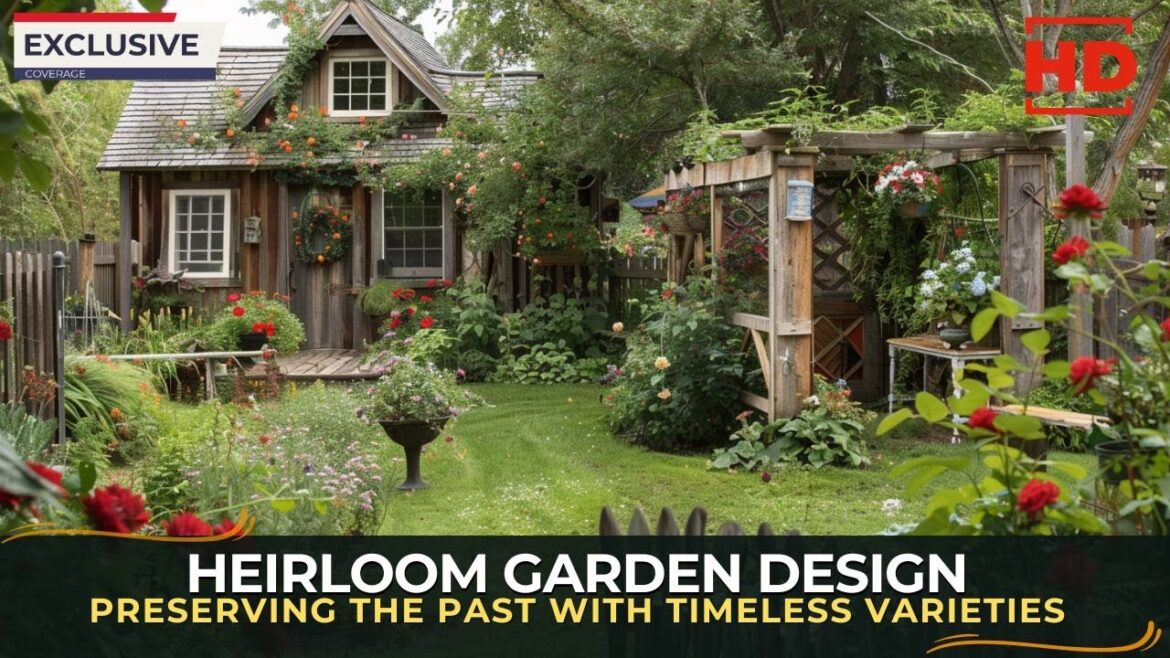Introduction
Heirloom gardens celebrate history and tradition by cultivating plant varieties passed down through generations. These gardens not only preserve the genetic diversity of plants but also offer unique flavors, colors, and forms. Designing an heirloom garden allows you to connect with the past while creating a beautiful, productive, and sustainable outdoor space. This guide explores how to design an heirloom garden, highlighting the benefits, key elements, and practical tips for cultivating timeless plant varieties.
Benefits of Heirloom Gardens
Genetic Diversity
– **Resilience**: Heirloom plants often have greater resistance to pests and diseases.
– **Adaptability**: They are well-adapted to local growing conditions, improving survival and yield.
Unique Characteristics
– **Flavor**: Many heirloom varieties offer superior taste compared to modern hybrids.
– **Aesthetics**: They come in a wide range of colors, shapes, and sizes, adding visual interest to your garden.
Cultural Heritage
– **History**: Growing heirlooms connects you to gardening traditions and the stories of past generations.
– **Sustainability**: Preserving heirloom seeds supports agricultural biodiversity and sustainability.
Key Elements of Heirloom Garden Design
Selecting Heirloom Varieties
Choosing the right heirloom plants is crucial for a successful garden.
Vegetables
– **Tomatoes**: Popular heirloom varieties include Brandywine, Cherokee Purple, and Mortgage Lifter.
– **Beans**: Consider Blue Lake, Kentucky Wonder, and Scarlet Runner.
Fruits
– **Apples**: Heirloom apple varieties like Gravenstein, Ashmead’s Kernel, and Cox’s Orange Pippin.
– **Berries**: Blackberries, raspberries, and strawberries with heirloom lineage offer unique flavors.
Flowers
– **Roses**: Antique varieties such as Gallica, Bourbon, and Damask roses.
– **Sunflowers**: Classic heirlooms like Mammoth Grey Stripe and Autumn Beauty.
Garden Layout
Planning your garden layout helps optimize space and plant health.
Raised Beds
– **Benefits**: Improved drainage, easier maintenance, and defined planting areas.
– **Design**: Arrange raised beds in grids or rows, allowing for crop rotation and companion planting.
Companion Planting
– **Synergy**: Plant combinations that benefit each other, such as tomatoes with basil and marigolds.
– **Pest Control**: Use companion planting to naturally deter pests and improve soil health.
Seed Saving
Preserving seeds from your heirloom plants ensures their continuity.
Techniques
– **Drying**: Allow seeds to dry completely before storing.
– **Storage**: Keep seeds in cool, dry, and dark conditions in labeled containers.
Benefits
– **Self-Sufficiency**: Reduce dependency on commercial seed sources.
– **Adaptation**: Over time, saved seeds adapt to your specific garden conditions.
Practical Tips for Designing an Heirloom Garden
Start Small
– **Manageable Size**: Begin with a small plot or a few raised beds to avoid being overwhelmed.
– **Focus**: Choose a select number of heirloom varieties to start, expanding as you gain experience.
Soil Preparation
– **Amendments**: Enrich the soil with compost and organic matter to support heirloom plants.
– **Testing**: Conduct soil tests to determine pH and nutrient levels, adjusting as necessary.
Watering and Maintenance
– **Consistent Watering**: Heirloom plants often have specific watering needs; use drip irrigation or soaker hoses for efficiency.
– **Regular Maintenance**: Weed regularly and monitor for pests to maintain plant health.
Incorporate Historical Elements
– **Garden Structures**: Use vintage or antique garden tools, furniture, and decor to enhance the historical ambiance.
– **Plant Labels**: Create decorative labels with the names and histories of each heirloom variety.
Conclusion
Designing an heirloom garden is a rewarding way to preserve the past while enjoying the unique benefits of timeless plant varieties. By selecting the right plants, planning an effective layout, and implementing sustainable practices like seed saving, you can create a beautiful and productive garden that honors tradition. Use these tips to cultivate an heirloom garden that connects you to history and enriches your gardening experience.
[Music] [Music] Heirloom Gardens celebrate history and tradition by cultivating plant varieties passed down through generations these Gardens not only preserve the genetic diversity of plants but also offer unique flavors colors and forms designing an heirloom Garden allows you to connect with the past while creating a beautiful productive and sustainable outdoor space this guide explores how to design an heirloom Garden highlighting the benefits key elements and practical tips for cultivating Timeless plant varieties [Music] what [Music] I [Music] benefits of Heirloom Gardens resilience heirloom plants often have greater resistance to pests and diseases adaptability they are well adapted to local growing conditions improving survival and yield flavor many heirloom varieties offer Superior taste compared to Modern hybrids Aesthetics they come in a wide range of colors shapes and sizes adding visual interest to your garden history growing heirlooms connects you to gardening traditions and the stories of past Generations sustainability preserving air Loom seeds supports agricultural biodiversity and sustainability [Music] I e [Music] practical tips for designing an heirloom Garden manageable size begin with a small plot or a few raised beds to avoid being overwhelmed Focus choose a select number of heirloom varieties to start expanding as you gain experience amendments enrich the soil with compost and organic matter to support heirloom plants testing conduct soil tests to determine pH and nutrient levels adjusting as necessary consistent watering heirloom plants often have specific watering needs use drip irrigation or soaker hoses for efficiency regular maintenance weed regularly and monitor for pests to maintain plant health [Music] conclusion designing an heirloom Garden is a rewarding way to preserve the past while enjoying the unique benefits of Timeless plant varieties by selecting the right plants planning an effective layout and implementing sustainable practices like seed saving you can create a beautiful and productive Garden that honors tradition use these tips to cultivate an heirloom Garden that connects you to history and enriches your gardening experience [Music]

